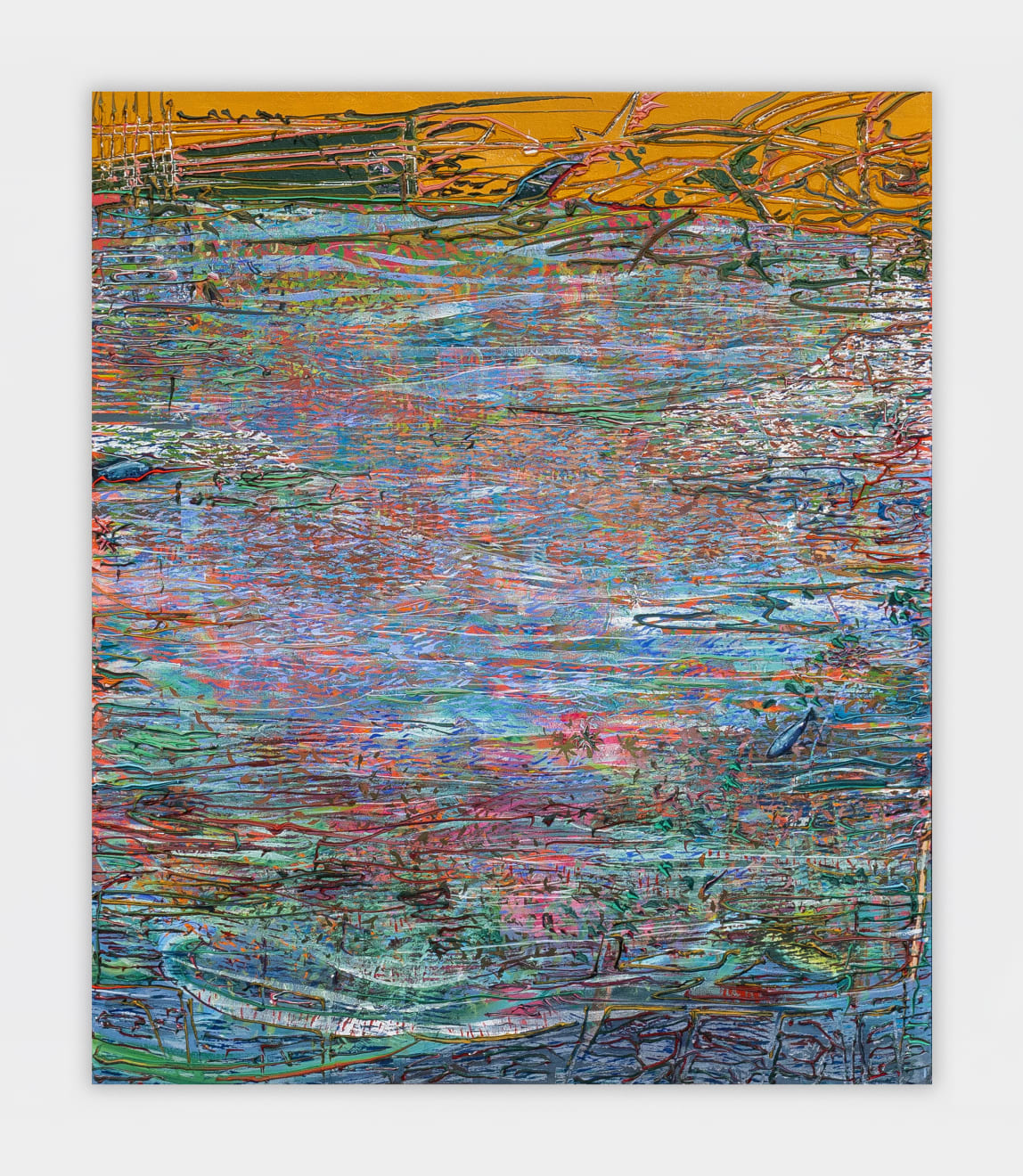Vinicius Gerheim
Pirapora, 2025
acrílica sobre tela
[acrylic on canvas]
[acrylic on canvas]
190 x 160 cm
[74 3/4 x 63 in]
3.6 kg
[74 3/4 x 63 in]
3.6 kg
Copyright O Artista
Apresentada no Grand Palais por Vinícius Gerheim, Pirapora representa a celebração de um percurso construído entre a sensibilidade e o rigor. Ao unir técnica, pesquisa e memória, o artista imprime...
Apresentada no Grand Palais por Vinícius Gerheim, Pirapora representa a celebração de um percurso construído entre a sensibilidade e o rigor. Ao unir técnica, pesquisa e memória, o artista imprime em larga escala os elementos que atravessam a sua trajetória de vida, misturando lembranças afetivas com referências à História da Arte ocidental.
O título Pirapora, de origem indígena Tupi-Guarani, significa “o salto do peixe” e evoca os fluxos das águas, infância e oralidade. A palavra, incorporada ao português no Brasil, mantém vivas memórias sociais e tradições coletivas, e ressoa como padrão sonoro — repetitivo, cíclico — em sintonia com as composições de padronagens visuais encontradas na pintura.
A estrutura da pintura coincide com os princípios da composição musical: camadas atmosféricas criam a base para o desenvolvimento de uma “caligrafia da paisagem”, onde folhas podem se transfigurar em peixes, penas, chamas, galhos ou rios vistos de longe. Esse trânsito livre entre formas naturais, aliado ao uso preciso das cores que se complementam entre texturas e volumes de tinta, propõe ao espectador uma ampliação da percepção, fundindo as relações entre figura e fundo para revelar o extraordinário no ordinário.
Pirapora é a expressão de um ofício da arte levado com paixão: se inscreve na pintura como linguagem, meio de existência, uma forma de devolver ao mundo a delicadeza com que um dia foi capturado pelo olhar de uma criança.
[Presented at the Grand Palais by Vinícius Gerheim, Pirapora represents the celebration of a path shaped by both sensitivity and discipline. By combining technique, research, and memory, the artist brings to large scale the elements that have marked his life’s journey, blending emotional memories with references to the history of Western art.
The title Pirapora, from the Indigenous Tupi-Guarani language, means “the leap of the fish” and evokes the flow of water, childhood, and oral tradition. The word, now part of Brazilian Portuguese, carries enduring social memories and collective traditions. It also resonates as a sonic pattern — repetitive and cyclical — in harmony with the visual motifs found throughout the painting.
The structure of the work mirrors the principles of musical composition: atmospheric layers provide the foundation for the development of a “landscape calligraphy,” in which leaves may transform into fish, feathers, flames, branches, or distant rivers. This fluid movement between natural forms, combined with the precise use of color — balanced across textures and volumes of paint — invites the viewer into an expanded perception, where figure and ground merge to reveal the extraordinary within the ordinary.
Pirapora is the expression of an artistic craft carried out with passion. It asserts itself in painting as language, as a way of being — a means of returning to the world the delicacy with which it was once seen through the eyes of a child.]
O título Pirapora, de origem indígena Tupi-Guarani, significa “o salto do peixe” e evoca os fluxos das águas, infância e oralidade. A palavra, incorporada ao português no Brasil, mantém vivas memórias sociais e tradições coletivas, e ressoa como padrão sonoro — repetitivo, cíclico — em sintonia com as composições de padronagens visuais encontradas na pintura.
A estrutura da pintura coincide com os princípios da composição musical: camadas atmosféricas criam a base para o desenvolvimento de uma “caligrafia da paisagem”, onde folhas podem se transfigurar em peixes, penas, chamas, galhos ou rios vistos de longe. Esse trânsito livre entre formas naturais, aliado ao uso preciso das cores que se complementam entre texturas e volumes de tinta, propõe ao espectador uma ampliação da percepção, fundindo as relações entre figura e fundo para revelar o extraordinário no ordinário.
Pirapora é a expressão de um ofício da arte levado com paixão: se inscreve na pintura como linguagem, meio de existência, uma forma de devolver ao mundo a delicadeza com que um dia foi capturado pelo olhar de uma criança.
[Presented at the Grand Palais by Vinícius Gerheim, Pirapora represents the celebration of a path shaped by both sensitivity and discipline. By combining technique, research, and memory, the artist brings to large scale the elements that have marked his life’s journey, blending emotional memories with references to the history of Western art.
The title Pirapora, from the Indigenous Tupi-Guarani language, means “the leap of the fish” and evokes the flow of water, childhood, and oral tradition. The word, now part of Brazilian Portuguese, carries enduring social memories and collective traditions. It also resonates as a sonic pattern — repetitive and cyclical — in harmony with the visual motifs found throughout the painting.
The structure of the work mirrors the principles of musical composition: atmospheric layers provide the foundation for the development of a “landscape calligraphy,” in which leaves may transform into fish, feathers, flames, branches, or distant rivers. This fluid movement between natural forms, combined with the precise use of color — balanced across textures and volumes of paint — invites the viewer into an expanded perception, where figure and ground merge to reveal the extraordinary within the ordinary.
Pirapora is the expression of an artistic craft carried out with passion. It asserts itself in painting as language, as a way of being — a means of returning to the world the delicacy with which it was once seen through the eyes of a child.]
